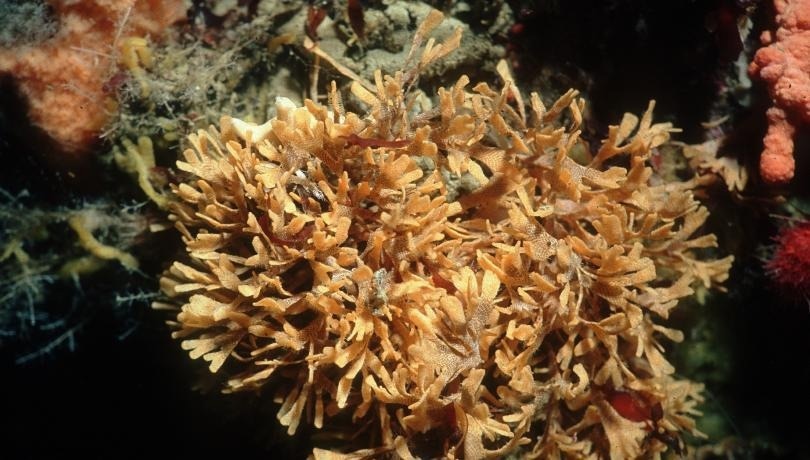According to a recent study, ocean acidification and global warming pose a threat to marine organisms like corals, bryozoans, mollusks, sea urchins, and crustaceans that assemble their skeletons and shells from calcium carbonate (chalk).
 Calcium carbonate in bryozoan skeletons is more soluble in the colder waters of polar regions. Image Credit: David Barnes (British Antarctic Survey)
Calcium carbonate in bryozoan skeletons is more soluble in the colder waters of polar regions. Image Credit: David Barnes (British Antarctic Survey)
The study was led by the Institut de Ciències del Mar (ICM-CSIC), with involvement from the British Antarctic Survey, the Institute of Oceanology, the Polish Academy of Sciences, and the University of Gdańsk.
The study, which was published in the journal Ecography, emphasizes organisms from the Southern Ocean near Antarctica that have calcium carbonate skeletons.
It is more difficult for these creatures to build their skeletons because calcium carbonate is more soluble in acidic waters that contain more carbon dioxide (CO2), such as the colder waters of the polar regions.
Bryozoans, Key for Understanding the Global Change Impacts on Calcifying Organisms
Researchers examined the skeletons of a group of marine organisms known as bryozoans, also referred to as moss animals. Bryozoans are small, filter-feeding invertebrates that live on the seafloor and can construct intricate habitats that improve biodiversity.
Like corals, bryozoans can live in colonies and build calcium carbonate skeletons, but they are more distributed geographically, especially in Antarctic waters. They make skeletons with a very diverse composition and are important carbonate producers in the Southern Hemisphere, making them excellent animals to study the effects of global change.
Blanca Figuerola, Study Lead Author and Researcher, Instituto de Ciencias del Mar
According to the expert, bryozoan skeletons are composed of the two primary forms of calcium carbonate, calcite or aragonite. However, they can also contain magnesium, which can make the skeletons more susceptible to acidification.
The largest dataset ever produced for Southern Ocean bryozoans was created through mineralogical analyses, allowing researchers to identify the various mineral types and quantify the amounts of magnesium present in Antarctic bryozoan skeletons.
The distribution of various mineral types and levels of magnesium in their skeletons was then compared with the temperature of the seawater in which they lived. They combined these mineral signatures with data already available from almost 500 species found in the Southern Hemisphere.
We found a clear pattern showing that species that have carbonate skeletons with high magnesium concentrations become more common with warmer seawater temperatures, and we see this trend on a global scale.
Huw Griffiths, Study Co-Author and Researcher, British Antarctic Survey
Figuerola stated, “This suggests that many marine species with high levels of magnesium in their skeletons will become more vulnerable to ocean acidification as seawater temperatures rise, and given the rapid changes observed and predicted in the temperature and chemistry of our oceans, these organisms may not have time to adapt to these new conditions.”
The International Bryozoology Association made significant contributions to expanding knowledge of skeletal mineralogy in a wide variety of bryozoan species from the poles to the tropics, which made it possible for the study to be conducted on such a large scale.
Marine Calcifiers’ Future
Seawater temperature and ocean chemistry are rising as a result of the rising CO2 emissions, which are also changing the oceans. Ocean acidification is the term used to describe the process by which the oceans absorb CO2. In addition, as carbonic acid is created when dissolved CO2 reacts with seawater, the concentration of carbonate in the water decreases.
Therefore, calcifying organisms must adapt to the decreased availability of carbonate and the increased acidity. These organisms use the calcium ions and carbonate ions dissolved in seawater to build their shells and skeletons.
It is still unclear how much calcifying species can modify the chemistry of their skeletons in response to the interaction of these (temperature and pH) stressors with other external stressors.
Given this situation, Figuerola is extending this research, carried out as part of the MedCalRes project (Grant PID2021-125323OA-I00, funded by MCIN/AEI/ 10.13039/501100011033 and by “ERDF A way of making Europe”), in collaboration with MedRecover participants and other researchers, to examine the potential morphological, metabolic, and microbiome responses of calcifying organisms, such as bryozoans and corals, to near-future ocean acidification and warming.
Journal Reference:
Figuerola, B., et al. (2022) Temperature as a likely driver shaping global patterns in mineralogical composition in bryozoans: implications for marine calcifiers under global change. Ecography. doi:10.1111/ecog.06381